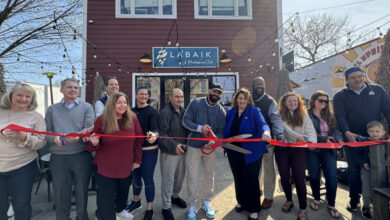Touring Twig
While walking along the picturesque streets of Old Town, with its rows of carefully preserved historical homes, it’s nearly impossible to resist the urge to catch a glimpse inside. One can’t help but wonder whether the interiors of these homes are as lovely as their charming facades suggest.
On Saturday, Sept. 23, The Twig’s 76th annual Historic Alexandria Homes Tour will allow attendees to do just that. The tour features eight homes on a five-block stretch of N. Columbus Street. The majority of the homes span the century between the early 1800s to the 1900s, but this year’s event also includes an innovative new green living space.
A Tradition of Service
The Twig, also known as the Junior Auxiliary of Inova Alexandria Hospital, is a non-profit organization that has been devoted to supporting Alexandria Hospital since 1933. Since its founding, the Twig has raised $3.9 million for the hospital. It is currently working towards completing its most recent one-million-dollar pledge, which will go towards helping the hospital renovate its cardiovascular intensive care unit.
The Twig is an organization run exclusively by women. Alexandria Hospital was also first begun by a group of dedicated women who recognized the need for more effective medical care in the aftermath of the Civil War. Founder Julia Johns and her Board of Lady Managers operated the
hospital out of a converted home and also started a nursing school and a horse-drawn ambulance service among other endeavors.1
Today, the Twig continues in the spirit of Julia Johns and her founding board of women volunteers with its tireless commitment to improving the hospital.
“We are very hard working,” said member Jane Matthias. “We take our mission to raise money very seriously. We are not a social organization. We work.”
The Twig raises money through a variety of avenues, including a thrift store on N. Columbus St. and seasonal bazaars held at the hospital. The Historic Alexandria Homes Tour, however, is the Twig’s most lucrative fundraiser.
The 2017 Historic Alexandria Homes Tour
According to 2017 Homes Tour Co-chair Amy Furr, she was walking along N. Columbus St. and was inspired by the charm of the buildings she saw. She and her fellow board members set about seeking homeowners along the stretch who wished to be included.
“It’s a good way to be part of the community and also a great chance to give back to a good cause,” said homeowner Tucker Bailey, whose home will be part of the tour. He added that he is hoping “to get to know some of the other homeowners.”
Bailey’s home was built in the late 1800s by esteemed capital-area architect Glenn Brown.2 The Romanesque Revival structure features bold arches of vibrant brick as well as dramatic iron, brass and copper details.
“I really loved the actual architecture itself,” Bailey said. “It was completely different from the other homes in the area. There are windows on three sides which bring a lot of openness and space to the house.”
While Bailey’s house has many historical features, such as the ornate mantelpieces over several of the home’s five fireplaces, the homeowner has added his own modern touches, including a wine cellar, an updated master bath and a walkout to the rooftop deck.
“The roof deck is what really sold me,” said Bailey, who has outfitted the space as a three-seasons entertainment space with a dining and lounge area, outdoor kitchen, fire pit and flat screen television.
Down the street, homeowner Guy Lamolinara agreed that “[the tour] is for a wonderful cause” and that he is “happy to share the house with anyone who would like to see.” He laughed and
added, that “it’s a great incentive to spiff up your house. The house will look better than it’s ever looked before.”
Lamolinara’s home dates from the late nineteenth century, although the property itself was bought and sold several times during the middle 1800s. Lamolinara admits that before being part of the Homes Tour, he didn’t know too much about the house’s history.
“I knew it was in the Boothe family and that it was built in 1895,” Lamolinara said. “I knew that it was connected to the Stabler-Leadbeater family.”
Lamolinara said he was originally drawn to the home because of some of its original details and the sense of comfort that he found walking through the historical home.
“In my personal opinion, a new home doesn’t have the same character and warmth. Even a new home that is built today with the same features won’t feel like the same as an older home that’s been lived in.”
Delving into Alexandria’s History
This year’s homes tour would not have been possible without the assiduous research of Homes Tour Co-chair Roberta Stevens. Stevens, who worked at the Library of Congress for many years managing the National Book Festival and was president of the American Library Association, used her professional skills to uncover all of the historical details she could find about each home.
“Only one home had extensive research on it,” Stevens said. “I did a deep dive into deed books in the Alexandria Courthouse and the collections in the Local History Room at the Queen Street Branch of the Alexandria Public Library. It was like putting together pieces of a puzzle and gradually seeing a picture emerge.”
Stevens used everything from “deeds, city directories, fire insurance maps, tax records, permits to build and news articles” to help her paint the pictures of each home’s history for this year’s tour guide, which she describes as just the crest of a tsunami wave of information.
Much of the research Stevens conducted alluded to a surge of development that occurred in Alexandria after the Civil War.
“The late 1800s saw a spurt of growth that moved north from King Street in response to the businesses serviced by railroads and the economic recovery post-Civil War,” Stevens said. “I saw the same names and real estate investment companies showing up over and over in the deeds. I found myself saying, ‘Hello old friend. I see you’re back again.’”
Despite the intensive work of research, which included lifting heavy historical deed books in addition to mental muscle power, Stevens has an unwavering enthusiasm for these homes and the efforts of their owners to maintain and improve them.
“[I enjoyed] meeting the owners and seeing how clearly the homes reflected their personalities, interests and creativity,” Stevens said. “They’ve put their financial resources and themselves into beautiful and beloved spaces to share with the Homes Tour participants.”
An Innovative Green Home
While the majority of the homes on the tour are historical, one of the properties is completely new and cutting-edge. It is part of Cromley Row, a development of Leadership in Energy and Environmental Design (LEED) certified townhomes.
LEED certification is a third-party rating system developed by the United States Green Building Council (USGBC). It assesses whether homes satisfy green living standards.
“The important thing to understand is that when you call something green, it has to mean something and that it’s not greenwashing,” said Bill Cromley, the architect who designed Cromley Row.
Cromley added that LEED certification isn’t just about the most obvious environmental factors such as efficient insulation and energy usage.
“It’s not just sustainability,” Cromley said. “It’s the health and safety of the home. There are mental health credits for creating a connection between the outside and the inside. It also takes into account the workers and residents who move into the homes when it comes to fumes from glues and paints.”
Some of the features of the home include a rainwater filtration system, geothermal heating and cooling, non-toxic carpets and paints and a light-filled open floor plan.
“It’s not just how a home looks but how you feel as you move through the space,” Cromley said. “A high window-to-wall ratio creates a connection to nature which can make you calmer and therefore healthier.”
In addition to its green features, the Cromley Row home on the tour is filled with the artistic touches of its owner, including original paintings, sculptures and decorative designs.
While the home itself is not historical, it sits on historic land, something the owner was acutely aware of when she purchased the home. According to Stevens, during her initial visit, “she walked to the end of the property and put down yellow flowers to honor the people who had been there before her.”
Researching Your Home
The history bug is contagious, and many Alexandria residents find themselves becoming local history experts. Learning about the background of a neighbor’s house may inspire some to delve into their own home’s roots.
While Stevens used her professional expertise to investigate the homes on the tour, she encourages everyone to do their own digging. She recommends starting with the Special Collections room at the Barrett Branch of the Alexandria Library, where she did much of her own research.
“The staff in the office are very willing to help and will show you how to navigate the online, book and microfilm files,” Stevens said. “It’s actually fun, and you find yourself feeling a connection with the people who lived in the homes a century or more ago.”
Alexandria is known for its cobblestone streets, brick sidewalks, waterfront views and historic homes, from stately nineteenth century Victorians to funky turn-of-the-century craftsmans. Ultimately, the Homes Tour is a way for Alexandria residents to celebrate the effort they put into maintaining such a beautiful and welcoming hometown.
“When people care about their homes and neighbors, an area thrives,” Stevens said. “The inside of houses may change but retaining the character of the home’s exterior brings a coherence and special quality to Alexandria.”




